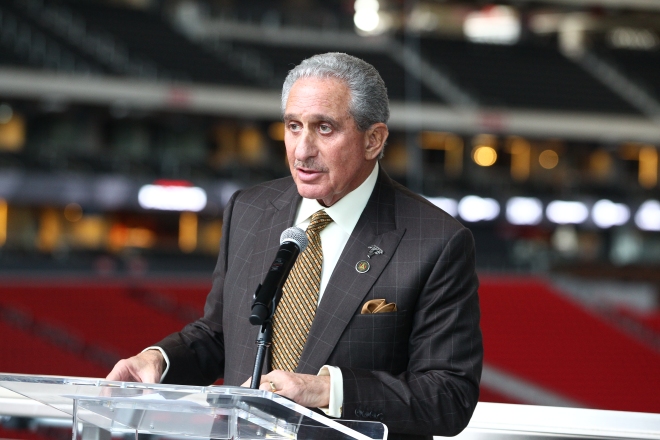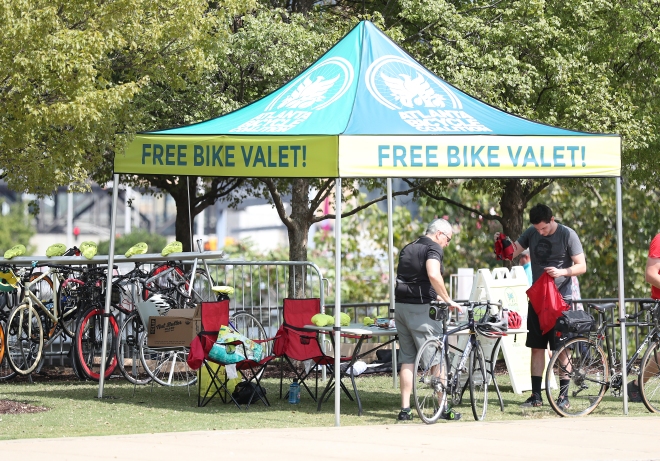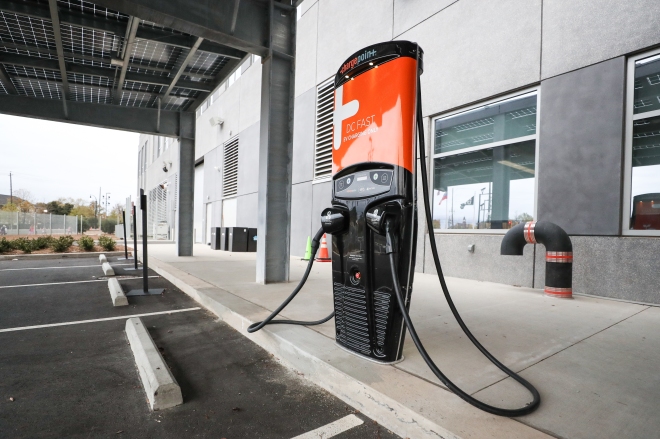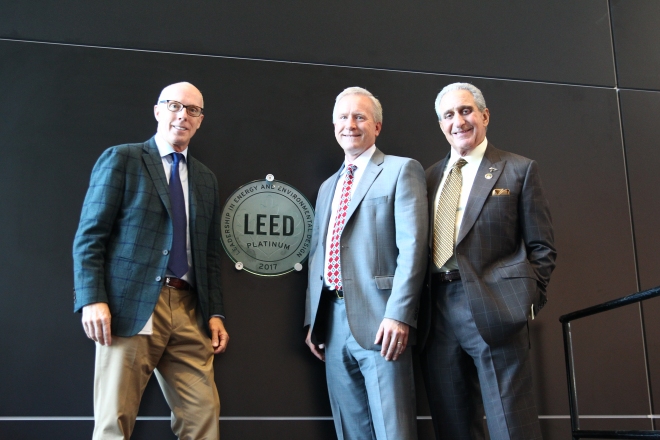SunTrust Park, now in its second season as home of the National League East-contending Atlanta Braves, earned LEED Silver certification, thanks to a number of innovative Green-Sports features. But situating the ballpark in suburban Cobb County, far from the MARTA rapid transit system, begs the question: How green is SunTrust Park? GreenSportsBlog toured the ballpark — as well as The Battery Atlanta, the adjacent mixed-use development — as part of the recent Green Sports Alliance Summit to find out.
EARNING LEED SILVER CERTIFICATION AT BREAKNECK SPEED
Building a $672 million stadium, from design to Opening Day, in 30 months is challenging.
Building a stadium so it qualifies for LEED certification in 30 months is, well, beyond challenging.
That was the task Rex Hamre, sustainability manager for real estate services firm JLL, and team was given by the Atlanta Braves at the start of the SunTrust Park design and construction process in 2013.
“Everything we did had to be done fast,” explained Hamre during a tour of the ballpark and the adjacent residential and commercial development, The Battery Atlanta. “For example, the process was so fast that we weren’t able to have a prototype for LED lights. There was some risk involved because we didn’t know if the quality of the lights would be good enough from a baseball point of view — those were early days for LEDs. We had to convince management the LEDs would work. We were able to do so and the lights worked great: they’re 50 percent more efficient than the old metal halides and were easier to install.”
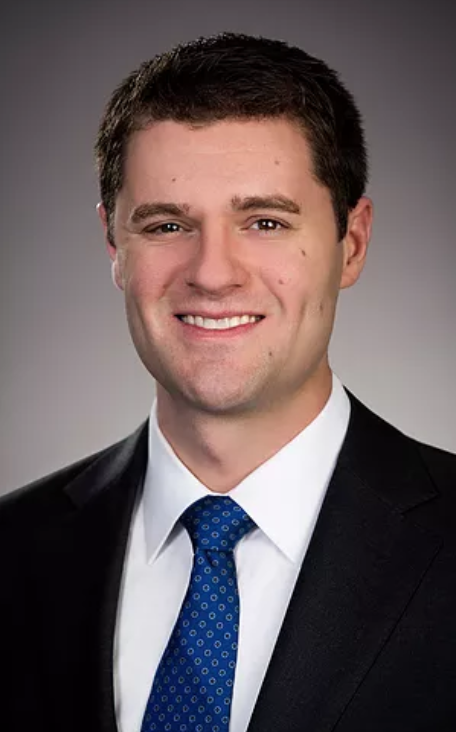
Rex Hamre of JLL (Photo credit: Engineers for a Sustainable World)
Efficiency is not the only benefit the LEDs bring to SunTrust Park. “The LEDs provide us with ‘Instant Restrike’. Metal halide bulbs get very hot. When they overheat, they can turn off and can stop a game. They take between 15 to 30 minutes to re-boot or ‘restrike’. When LEDs turn off, they restrike immediately.”
SUNTRUST PARK: COOLLY EFFICIENT, IN A BIG (ASS) WAY
Efficiently cooling a big venue like a baseball stadium — especially in the steamy Atlanta summer — is a big challenge. For SunTrust Park to improve on cooling efficiency vs. its smaller predecessor, Turner Field, made the test even tougher.
“We have 200,000 square feet more to air condition at SunTrust Park than at Turner Field,” Hamre acknowledged. “Despite that significant difference, we are more efficient at SunTrust Park due to an incredibly efficient central AC system. Also we paid very close attention to design of the building envelope*, which also helped a lot.”
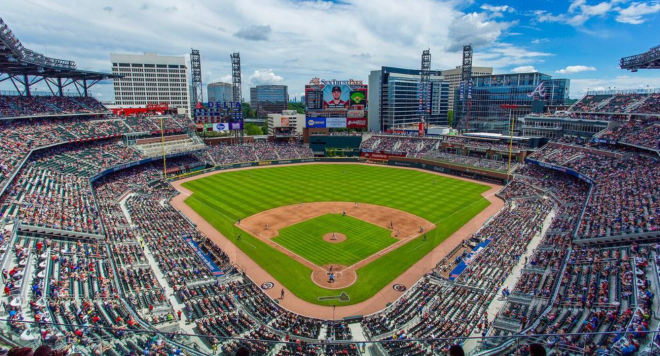
SunTrust Park, LEED Silver certified home of the Atlanta Braves (Photo credit: Ballparks of Baseball)
Braves management decided to invest more upfront for HVAC and chillers, with the confidence that the investment would pay off within 5-10 years.
“We looked at a variety of chillers,” Hamre said. “The chiller we chose was best from a carbon emissions perspective.”
And then, of course, there are the Big Ass Fans.
I know what you’re thinking.
“What happened to the propriety that is the hallmark of GreenSportsBlog?”
Not to worry.
Big Ass is a brand name for really, really big fans. We’re talking 22 feet by 16 feet fans.^ I saw them interspersed throughout SunTrust Park. Let’s just say they are aptly named.
And they are very energy efficient.

One of the energy efficient Big Ass Fans at SunTrust Park (Photo credit: Atlanta Braves)
Also big is the 40,000 gallon water resiliency tank that is helping SunTrust Park, along with its neighboring mixed-use development, The Battery Atlanta, recycle 50 percent of its H₂O.
THE BATTERY ATLANTA: GOING GREEN ALONGSIDE SUNTRUST PARK
Sustainability is embedded in the DNA of The Battery Atlanta, which opened at the same time as SunTrust Park. The Battery Atlanta:
- Boasts three residential buildings with 531 apartments (aiming for LEED certification), office buildings and a retail strip, filled with sports bars, cafes, apparel shops, a 4,000 person entertainment theater, a four-star hotel, and more
- Is the home of Comcast’s new LEED certified southeast regional headquarters
- Has 63 electric vehicle (EV) chargers, including several Level 3 fast-chargers (80 percent charge in 30 minutes)

Aerial view of The Battery Atlanta mixed-use development in the foreground with SunTrust Park in the rear (Photo credit: ajc.com)
Neither solar power nor energy storage are part of the SunTrust Park/The Battery Atlanta as of now. But, as the economics for both continue to improve, there appears to be the available physical space required.
NOW, ABOUT BUILDING A BALLPARK IN THE SUBURBS…
The 1992 opening of Camden Yards, home of the Baltimore Orioles kickstarted the positive trend of locating new baseball stadia in or near urban centers, close to mass transit.
A notable exception are the Atlanta Braves.
Ownership’s (Liberty Media Group) decision to build SunTrust Park in the northern suburbs of Cobb County, far from the MARTA light rail system, was controversial. Critics, including GreenSportsBlog, argued that leaving centrally located and a relatively young Turner Field (20 years-old when the Braves left after the 2016 season) for an area with limited mass transit was the wrong choice from a carbon footprint perspective. Consider that fan travel is the biggest component of greenhouse gas emissions (GHGs) at a sports event. Unless someone rides a bike, walks or takes a local Cobb County bus, odds are, fans going to SunTrust Park are going to drive — or take an Uber or Lyft.
It should be noted that Turner Field, now the home of Georgia State University football, is not as centrally located as I thought: it is about one mile south of downtown. Thus it is not that close to MARTA — it takes an estimated 20-25 minutes to walk from the closest station.
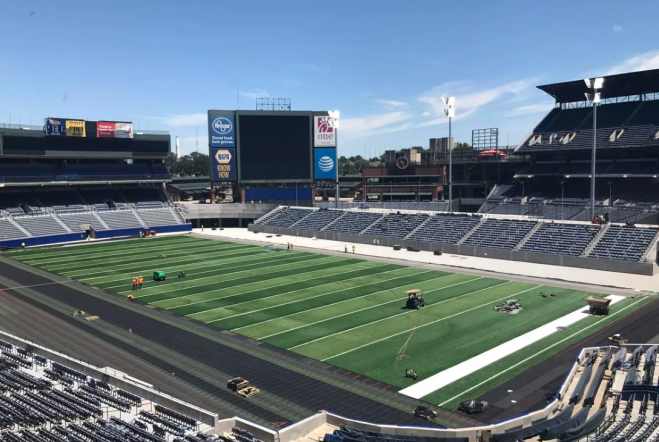
Turner Field, formerly the home of the Atlanta Braves, in its new football configuration for Georgia State University (Photo credit: Curbed.com)
Turner Field will be much closer to mass transit as early as 2024 thanks to a new, $48.6 million MARTA Bus Rapid Transit (BRT) line, funded in part by a $12.6 million federal government grant. Construction is scheduled to commence in 2021 on the BRT# line that will connect Turner Field to Atlanta’s downtown and midtown areas.
Ironically, according to a March 7, 2018 story in Atlanta Journal Constitution (AJC) by David Wickert and J. Scott Trubey on the federal grant, “The Atlanta Braves wanted a direct connection to MARTA when they were in talks with the city to remain at the former Turner Field, before the ballclub left for the new SunTrust Park in Cobb County.”
Would the BRT line have been enough to have kept the Braves at Turner Field? We will never know.
We do know that the Braves report that, when they were looking for locations for the new ballpark, they created a “heat map” showing the location of each ticket sold. The map shows SunTrust Park to be 12 miles closer to the majority of those addresses than Turner Field. If that is true, then it is possible that the move to the suburbs is saving on vehicle miles driven because the new ballpark is closer to the team’s fan base.
Long term, as the population increases in fast-growing Cobb County, the push for new mass transit that would feed into SunTrust Park and The Battery Atlanta, including BRT and HighRoad Rapid Transit (monorail), is expected to grow. But the politics of getting big mass transit infrastructure projects funded is a fraught process, to say the least. So it’s anybody’s guess as to when mass transit will come to SunTrust Park.
Of course, Liberty Media Group could have made mass transit access a moot point if it had chosen a site close to an existing MARTA station for its new stadium. I’m not expert enough on Atlanta mass transit, real estate and demographics to know if that was a real option. But, as the saying goes, where there’s a (green) will there’s a (greener) way.
* Building envelope = the physical separator between the conditioned and unconditioned environment of a building
^ There are also 14 feet x 8 feet Big Ass Fans at SunTrust Park
# BRT lines run with limited stops and operate in a mix of exclusive lanes and shared roadways.

